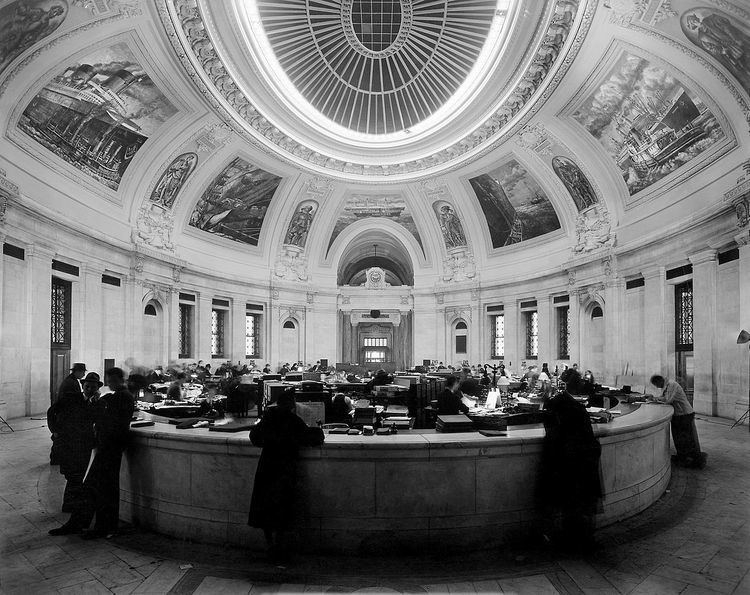 | ||
The Treasury Relief Art Project was a New Deal arts program that commissioned visual artists to provide artistic decoration for existing Federal buildings during the Great Depression in the United States. A project of the United States Department of the Treasury, TRAP was administered by the Section of Painting and Sculpture and funded by the Works Progress Administration, which provided assistants employed through the Federal Art Project. The Treasury Relief Art Project also created murals and sculpture for Public Works Administration housing projects. TRAP was established July 21, 1935, and continued through June 30, 1938.
Contents
Program
The Treasury Relief Art Project was created July 21, 1935, with an allocation of $530,784 from the Works Progress Administration. The project was conceived and overseen by Treasury Department arts administrator Edward Bruce. Artist Olin Dows was chief of the Treasury Relief Art Project; Cecil H. Jones, who later succeeded Dows, was assistant chief. Forbes Watson was director. Unlike the concurrent Treasury Section of Painting and Sculpture, TRAP was a work-relief program, subject to the income and employment standards of the WPA. The September 1935 announcement of the program estimated that it would employ 400 to 500 artists.
The principal mission of the Treasury Relief Art Project was to provide artistic decoration for existing Federal buildings. These projects could not be performed by the Section of Painting and Sculpture, which commissioned art for new construction using a percentage of the budget overseen by the Treasury Department's procurement division. The Treasury Relief Art Project was funded by the WPA. The Section supervised the creative output of TRAP, and selected a master artist for each project. Assistants were then chosen by the artist from the rolls of the WPA Federal Art Project.
As chief of the Treasury Relief Art Project, Dows was responsible for maintaining financial records for relief and non-relief personnel. A fixed proportion of all workers was to be taken from the relief rolls—initially 90 percent, but revised to 75 percent in December 1935.
Although it was regarded as a success, the Treasury Relief Art Project was ended June 30, 1938.
Projects
At a total cost of $833,784, 89 mural projects and 65 sculpture projects were completed under the Treasury Relief Art Project, as well as 10,000 easel paintings that were distributed to Federal offices.
Reginald Marsh was the master artist commissioned in 1937 to create a cycle of murals in fresco for the rotunda of the Alexander Hamilton U.S. Custom House. Marsh's team of assistants included Oliver M. Baker, Xavier J. Barile, Charles Bateman, Mary Fife, Lloyd Lozes Goff, Ludwig Mactarian, John Poehler, Erica Volsung and J. Walkley, students he knew from his teaching at the Art Students League. It was TRAP's most extensive and successful project in New York, encompassing 2,300 square feet.
Existing post office buildings that received TRAP artwork included the following:
In addition to producing artwork for Federal buildings, the Treasury Relief Art Project created murals and sculpture for Public Works Administration housing projects in Boston, Camden, Chicago, Cleveland, New York, Washington, D.C. and Stamford.
Artists
To maintain its high artistic standards, the Treasury Relief Art Project commissioned only a small number of artists—356 workers at its peak in 1936. Richmond Barthé, Ahron Ben-Shmuel, Paul Cadmus, Marion Greenwood, William Gropper, Reginald Marsh and Heinz Warneke were among the master artists who led projects. A complete list of projects and artists employed by TRAP is included in the final report held by the Smithsonian's Archives of American Art.
